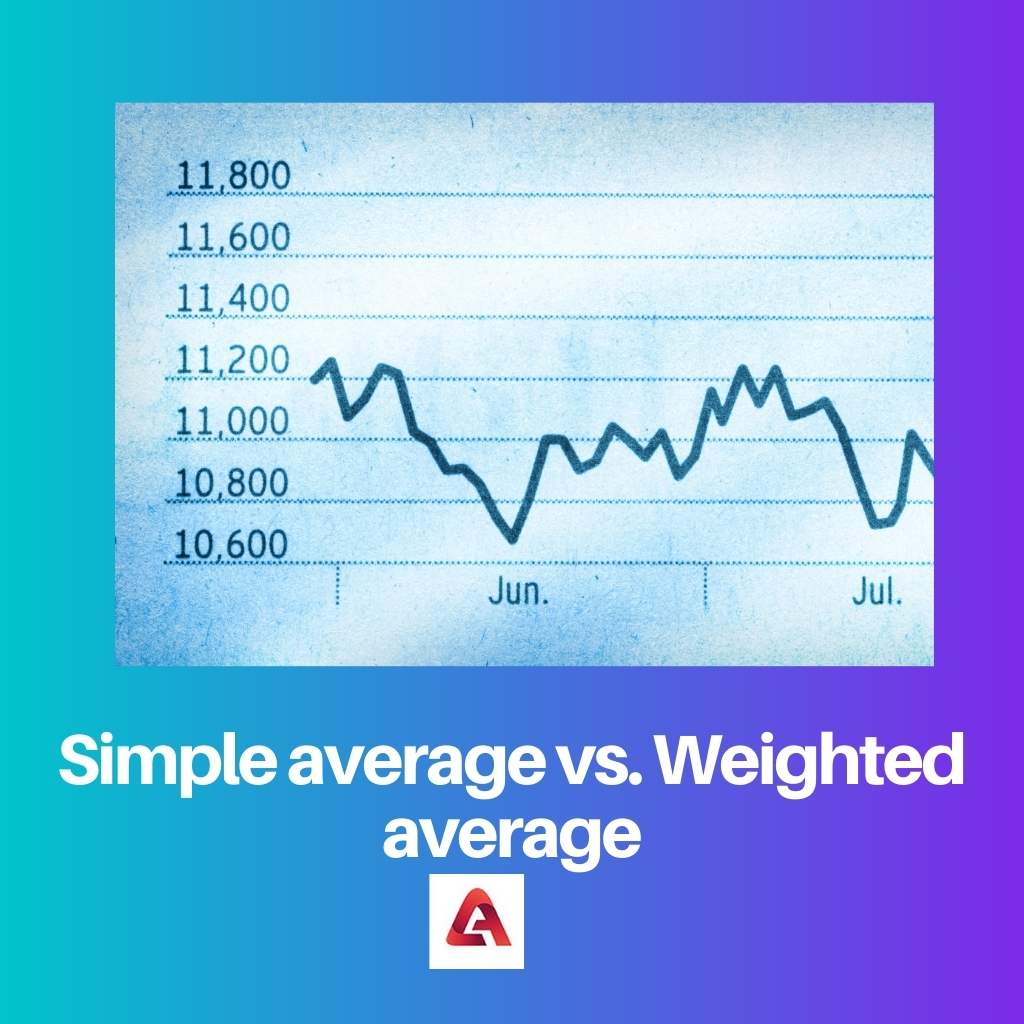A simple average and a weighted average are Some of the world’s largest and most commonly used stats. Both weighted and averages have benefits and inconveniences, as well as specific applications.
Key Takeaways
- Simple averages calculate the sum of all values divided by the number of values, treating each value equally.
- Weighted averages assign different weights to values, reflecting their relative importance.
- Weighted averages provide a more accurate representation in situations where values have varying significance.
Simple average vs Weighted average
A simple average is the sum of a set of numbers divided by the total number of numbers in the set. It treats all the numbers equally and gives them the same weight in the calculation of the average. A weighted average is one that takes into account the values and their importance or weight.

A set of observations’ simple averages is calculated by multiplying the total of the individual observations by the number of observations in the set.
The simple average, on the other hand, has a wide range of applications, and its computation is always aided in practice by supplementary averages, such as weighted averages or simple moving averages, due to its inability to be impacted by extreme values.
Comparison Table
| Parameters of Comparison | Simple average | Weighted average |
|---|---|---|
| Basic Definition | The Simple Average combining all sample observations and splitting it up by the number of observations in the sample, a mean is calculated. | A weighted average is some kind of averaging whereby each observation in the data collection is weighted before being combined to produce one assessment completed. |
| Formula | Average = ∑(x) / n | Weighted Average = ∑(xiwi) / ∑wi |
| Conditions | Just because all of the data are evenly weighted will this average operate. | Each observation in a weighted average is allocated a frequency or a specified weight. |
| Use case | There are no specified circumstances in which the basic average must be used. | When you have a set of observations, each of which has a frequency associated with it. |
| Result indication | The average is sometimes called the middle trend since it is employed to identify and generalize the interquartile range. | The weighted average shows, and will rely on, the majority of the observations. And is used in accounting most often. |
What is a Simple average?
The major advantage of the simple average is how simple it is to calculate.
However, one disadvantage of the simple average approach is that it may not accurately reflect an average, especially if the items in the collection have different significance.
As a result, a simple average is a useful approach for calculating the average of a group of variables with equal relevance. The use of a weighted average may be more accurate in other instances.
It is a technique for inventory valuation or delivery cost computation in which the average unit cost is determined by multiplying the total of these unit costs by the number of receiving, even if the inventory products have varying unit costs.
What is the Weighted average?
The weighted average has one major flaw: the weights assigned might be subjective, which has an impact on the computation. In the case of basic calculations, however, this is not the situation.
A weighted average could be more precise than a basic average, which assigns the same weight to all values in a data collection.
The most common use of a weighted average is to equalize the frequency of values in a data collection.
If participants in a ballet class are assessed on skill, attendance, and etiquette, the skill grade may carry more weight than the other elements.
Main Differences Between Simple average and Weighted average
- Observations are believed to be similarly considered when using a simple average. In the case of a weighted average, on the other hand, a separate value is assigned for each observation, a unique value.
2. Outliners and absolute values impact the simple average, but neither the extreme value nor the outliners affect the weighted average.
- https://ieeexplore.ieee.org/abstract/document/906120/
- https://www.ncbi.nlm.nih.gov/pmc/articles/PMC5287121/
Last Updated : 20 August, 2023


Emma Smith holds an MA degree in English from Irvine Valley College. She has been a Journalist since 2002, writing articles on the English language, Sports, and Law. Read more about me on her bio page.

This is a well-organized and in-depth explanation of the topic.
The article effectively highlights the benefits and drawbacks of each type of average. Well done.
I appreciate the detailed insights. This is a must-read for anyone studying statistics.
Definitely a well-thought-out article that provides a comprehensive overview.
The article does an excellent job of breaking down the differences between simple averaging and weighted averaging. It’s an invaluable resource for academics and professionals alike.
Absolutely. The article is insightful and educational.
The explanations are comprehensive and clear. This is a very informative article.
I totally agree. The amount of information is great.
The article is very well-written. It provides a good explanation of the subject matter.
Absolutely. I appreciate the depth of the content.
I found the definitions and use cases to be quite insightful.
Yes, the details provided are very useful and well-articulated.
Detailed comparison and the underlying concepts are very well explained. I really enjoyed reading this article.
Agreed. It’s a great read for anyone interested in this topic.
The article does a great job of presenting the differences between simple average and weighted average. It’s an important read for statisticians.
I couldn’t agree more. This is a valuable source of information.